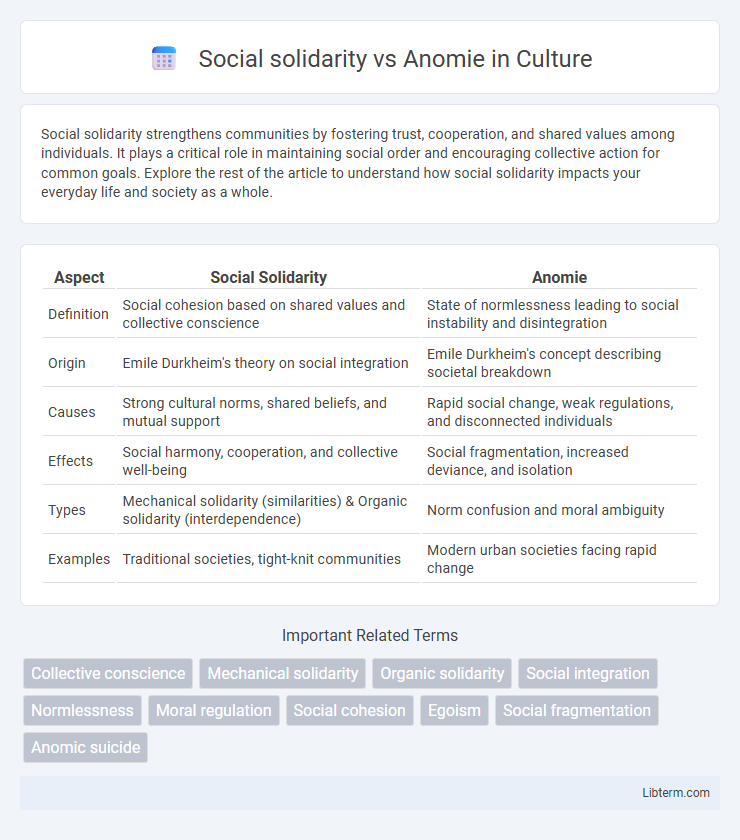Social solidarity strengthens communities by fostering trust, cooperation, and shared values among individuals. It plays a critical role in maintaining social order and encouraging collective action for common goals. Explore the rest of the article to understand how social solidarity impacts your everyday life and society as a whole.
Table of Comparison
| Aspect | Social Solidarity | Anomie |
|---|---|---|
| Definition | Social cohesion based on shared values and collective conscience | State of normlessness leading to social instability and disintegration |
| Origin | Emile Durkheim's theory on social integration | Emile Durkheim's concept describing societal breakdown |
| Causes | Strong cultural norms, shared beliefs, and mutual support | Rapid social change, weak regulations, and disconnected individuals |
| Effects | Social harmony, cooperation, and collective well-being | Social fragmentation, increased deviance, and isolation |
| Types | Mechanical solidarity (similarities) & Organic solidarity (interdependence) | Norm confusion and moral ambiguity |
| Examples | Traditional societies, tight-knit communities | Modern urban societies facing rapid change |
Understanding Social Solidarity: Definition and Importance
Social solidarity refers to the bonds that connect individuals within a society, fostering a sense of belonging and mutual support essential for social cohesion. It plays a crucial role in maintaining order and stability by promoting shared values and collective conscience. Understanding social solidarity highlights its importance in preventing anomie, a state of normlessness that leads to social disintegration and individual alienation.
The Concept of Anomie in Sociology
Anomie in sociology refers to a state of normlessness where societal norms and values become unclear or eroded, leading to social instability. Emile Durkheim introduced the concept to explain how rapid social changes or disruptions in social solidarity can cause individuals to feel disconnected and unregulated. This lack of cohesive social norms often results in increased deviance, alienation, and a breakdown in social order.
Historical Context: Durkheim’s Theories on Society
Emile Durkheim's theories on social solidarity and anomie emerged from his analysis of modern society's transition from traditional to industrial structures. He identified mechanical solidarity in pre-industrial societies, based on shared beliefs and homogeneity, contrasting with organic solidarity in industrial societies, characterized by interdependence and specialization. Durkheim introduced anomie to describe the normlessness and social instability resulting from rapid social change and weakened collective conscience during this transition.
Indicators of Social Solidarity in Modern Communities
Social solidarity in modern communities is often measured through indicators such as the strength of social networks, levels of civic participation, and shared norms or values that promote cooperation. High rates of volunteerism, community engagement, and trust among members signal robust social cohesion, counteracting the fragmentation associated with anomie. Monitoring patterns of social integration, including participation in local organizations and intergroup interactions, provides critical insights into the persistence of social solidarity in contemporary society.
Causes and Consequences of Anomie
Anomie arises from rapid social change or breakdown in social norms, leading to a state of normlessness where individuals feel disconnected from the collective conscience. This condition results in increased feelings of alienation, social instability, and higher rates of deviance or crime, as traditional social bonds weaken. Social solidarity, by reinforcing shared values and norms, counteracts anomie by promoting cohesion and collective identity within communities.
Social Solidarity vs Anomie: Key Differences
Social solidarity refers to the cohesion and integration of individuals within a society through shared values and norms, while anomie describes a state of normlessness resulting from social instability or rapid change. Key differences lie in their effects: social solidarity promotes social order and collective conscience, whereas anomie leads to social disintegration and increased deviance. Emile Durkheim's studies highlight social solidarity as essential for societal stability, in contrast to anomie, which undermines social cohesion.
The Role of Institutions in Fostering Solidarity
Institutions such as family, education, and religion play a crucial role in fostering social solidarity by promoting shared values, norms, and collective conscience within a society. When these institutions function effectively, they reduce feelings of anomie, a state of normlessness where individuals feel disconnected from the collective social fabric. Strong institutional frameworks ensure social integration, thereby maintaining societal cohesion and stability.
Effects of Anomie on Individual and Collective Behavior
Anomie disrupts social solidarity by weakening the shared norms and values that bind individuals, leading to increased feelings of alienation and purposelessness. Individuals experiencing anomie often exhibit deviant behavior, decreased social participation, and a heightened sense of isolation. Collectively, anomie can result in social fragmentation, reduced community cohesion, and a decline in collective efficacy.
Strategies to Combat Anomie and Strengthen Social Bonds
Strategies to combat anomie emphasize fostering social solidarity through community engagement, promoting shared norms, and enhancing social networks to reduce feelings of isolation. Strengthening social bonds involves encouraging collective activities, supporting family and educational institutions, and implementing policies that address social inequalities. These approaches help build a sense of belonging and purpose, mitigating the social fragmentation associated with anomie.
Future Challenges: Maintaining Solidarity in a Rapidly Changing World
Rapid technological advancements and increasing social fragmentation pose significant challenges to maintaining social solidarity in modern societies. Urbanization and digital communication often weaken traditional community bonds, leading to feelings of alienation and anomie. Developing inclusive policies that foster social cohesion and shared values is essential to counteract these trends and ensure collective identity in the future.
Social solidarity Infographic

 libterm.com
libterm.com